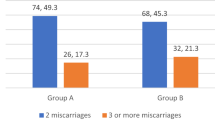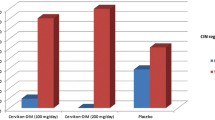Abstract
In a double-blind placebo-controlled comparative study, 180 female patients were randomly assigned to groups and treated approximately 3 h before dilatation and curettage with either a single 1 mg vaginal suppository of Gemeprost or a matching placebo. The patient population included premenopausal non-pregnant or postmenopausal patients presenting at four participating centers in West Germany. Patients were monitored from the time of drug administration to approximately 24 h after the operation. A marked response to treatment with Gemeprost was noted at the general cervical assessment performed immediately prior to dilatation. A significant increase in diameter of the cervical canal was observed and subsequent mechanical dilatation was found to be significantly easier as a result of Gemeprost treatment. No differences between the response to treatment in premenopausal and postmenopausal patients were found in our interim analysis of 113 patients. The incidence of preoperative uterine pain increased with time as a result of Gemeprost treatment but it was predominantly mild and no analgesics were required. Gastrointestinal side-effects were rare and well tolerated in both treatment groups. This study indicates that Gemeprost is an effective, well tolerated preoperative cervical dilator/softener in non-pregnant patients.
Resumé
Lors d'une étude comparative conduite en double-aveugle contre placebo, 180 malades ont été affectées par randomisation à l'un des deux groupes suivants: un groupe traité environ 3h avant la dilatation et le curetage par un ovule vaginal de GemeprostR à 1 mg, et l'autre par un placebo apparié. La population étudiée était constituée de malades préménopausées, non enceintes, et de femmes ménopausées; l'étude a été conduite dans 4 centres en RFA. Les malades ont été suivies depuis le moment d'administration du médicament jusqu'à environ 24 heures après l'opération. L'examen global du col pratiqué juste avant la dilatation a montré un effet net du GemeprostR. On a observé une augmentation significative du diamètre du canal cervical dans le groupe GemeprostR; dans ce même groupe, la dilatation mécanique ultérieure a été nettement plus facile. L'analyse préliminaire, portant sur 113 malades, n'a pas montré de différences entre les femmes préménopausées et les femmes ménopausées quant à la réponse au traitement. Dans le groupe GemeprostR, l'incidence des douleurs utérines pré-opératoires a augmenté au fil du temps, mais il s'agissait de douleurs généralement discrètes, qui n'ont pas imposé la prescription d'analgésiques. Les effets secondaires gastro-intestinaux ont été rares et bien tolérés dans les 2 groupes. Cette étude montre que chez les malades non enceintes, le GemeprostR constitue un moyen efficace et bien toléré d'obtention d'une dilatation/d'un ramollissement du col utérin en pré-opératoire.
Resumen
En un estudio comparativo doble-ciego controlado con placebo, 180 pacientes femeninas fueron asignadas al azar a grupos y tratadas, aproximadamente 3h antes de una dilatación y curetaje, con un solo supositorio vaginal de GemeprostR de 1 mg o un placebo similar. El grupo de pacientes incluía premenopausicas no embarazadas o postmenopausicas, presentes en cuatro centros participantes en Alemania Occidental. Las pacientes estuvieron controladas desde el momento que se les suministró la droga hasta aproximadamente 24h después de la operación. Se notó una marcada respuesta al tratamiento con GemeprostR durante la evaluación general cervical efectuada previamente a la dilatación. Se observó un aumento significativo en el diámetro del canal cervical y la dilatación mecánica subsecuente resultó ser significativamente más sencilla como resultado del tratamiento con GemeprostR. En nuestro análisis interino de 113 pacientes, no se encontraron diferencias en la respuesta al tratamiento entre pacientes premenopausicas y postmenopausicas. La incidencia de dolor uterino preoperatorio aumentó con el tiempo comu resultado del tratamiento con GemeprostR, pero fué predominantemente leve y no se requirieron analgésicos. Los efectos colaterales gastrointestinales fueron raros y bien tolerados por ambos grupos. Este estudio indica que el GemeprostR es un dilatador/ablandador cervical preoperatorio efectivo y bien tolerado en pacientes no embarazadas.
Similar content being viewed by others
References
CraftI. (1973). The use of prostaglandin pessaries prior to vaginal termination.Prostaglandins,3, 377–381
Chen, J. K. and Elder, M. G. (1984). Preoperative cervical dilatation by vaginal pessaries containing PGE1 analog.Obstet. Gynecol. (In press)
ChristensenN. J., BydegmanM. and GreenK. (1983). Comparison of different prostaglandin analogues and laminaria for preoperative dilatation of the cervix in late first trimester abortion.Contraception,27, 51–61
WelchC. and ElderM. G. (1982). Cervical dilatation with 16,16′-dimethyl-trans-Δ2 PGE1 methyl ester vaginal pessaries before surgical termination of first trimester pregnancies.Br. J. Obstet. Gynaecol.,89, 849–852
PrasadR. N. V., LimC., WongY. C. et al. (1978). Vaginal administration of 16,16′-dimethyl-trans-Δ2 PGE1 methyl ester (ONO 802) for preoperative cervical dilatation in first trimester nulliparous pregnancy.Singapore J. Obstet. Gynecol.,9, 69–71
ZahradnikH. P., BeyorJ., Schillfart et al. (1979). Are Hegar's rods omissible?.Geburtsh. u. Frauenheilk,39, 43–45
Mandelin, M., Kajanoaja, P., Ylikorkala, P.et al. (1985). A double-blind placebo controlled multicenter study of 1 mg vaginal pessaries of 16,16′-dimethyl-trans-Δ2 PGE1 methyl ester for termination of first trimester pregnancy. Data in file of May & Baker
HillierK. and CoadN. (1982). Synthesis of prostaglandins by the human cervixin vitro during passive mechanical stretch.J. Pharm. Pharmacol.,34, 262–263
MackenzieI. Z. (1981). Clinical studies on cervical ripening. In:The Cervix in Pregnancy and Labor, D. A.Ellwood and A. B. M.Anderson, eds., Churchill Livingstone, Edinburgh, pp. 163–186
HillierK. and WallisR. M. (1981). Prostaglandins, steroids, and the human cervix. In:The Cervix in Pregnancy and Labor, D. A.Ellwood and A. B. M.Anderson, eds., Churchill Livingstone, Edinburgh, pp. 149–162
AnthonyG. S., FisherJ., CouttsJ. R. T. and CalderA. A. (1982). Forces required for surgical dilatation of the pregnant and non pregnant human cervix.Br. J. Obstet. Gynaecol.,89, 913–916
Rabe, T., Helk, J., Kiesel, L., Runnebaum, B. and Kubili, F. (1983). The use of Gemeprost (ONO 802) as a preoperative cervical dilator prior to vacuum aspiration in the first trimester of pregnancy. Unpublished data
SmithS. K. and BairdD. T. (1980). The use of 16,16′-dimethyl-trans-Δ2 PGE1 methyl ester vaginal suppositories for the termination of early pregnancy. A comparative study.Br. J. Obstet. Gynaecol.,87, 712–717
Author information
Authors and Affiliations
Rights and permissions
About this article
Cite this article
Rabe, T., Willinger, G., Kiesel, L. et al. Study of 91-191-191-1prostaglandin E1 methyl ester vaginal suppository for cervical dilatation in premenopausal and postmenopausal women. Adv Contracept 1, 91–102 (1985). https://doi.org/10.1007/BF01849148
Received:
Accepted:
Issue Date:
DOI: https://doi.org/10.1007/BF01849148




